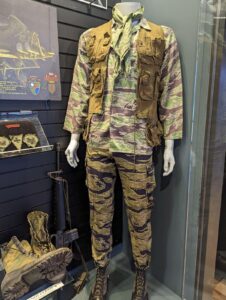Whenever I ask you to imagine your idea of a special forces unit in the Vietnam War, you’ve probably got a couple ideas in mind. They’re most likely in boonie hats, with a full load of equipment and possibly standing in the middle of nowhere in a rainy jungle. You might also think of John Wayne in Green Berets, or the Disney classic Operation Dumbo Drop. The factors may differ in people’s imagination, but most likely, you all envision them in tiger stripe camouflage. The tiger stripe camouflage established itself as a recognizable camouflage because of its association with the United States Army’s special forces units operating throughout the Vietnam War.

The source for tiger stripe camouflage actually began in WWII with the British Denison camo worn by British special operations and paratrooper regiments. This camouflage was a khaki based camouflage with the variation stripes actually applied by hand using large bushes, which causes an immense level of variance, as no two items using the camo are exactly the same. That method of design is actually how the Denison pattern got the nickname of a “brushstroke” camo.
The French successor followed soon after the end of WWII with the invention of the TAP47 pattern camouflage, more plainly called the Lizard pattern.This patterned camouflage was used by French paratroopers in both the French Indochina and the Algerian colonial wars. The “Lizard” camo uses the same khaki base as the Denison pattern, but adds its own flair. The brushstrokes forming the shapes to disrupt the wearer’s silhouette are typically smaller than the Denison pattern and follow either a horizontal or vertical pattern.

Once the French colonial forces were defeated in Vietnam, they left, but their camo stayed.
Adopted by the Republic of Vietnam Marines, the Lizard pattern still saw some use beyond French occupation. Soon, however, the shift to tigerstripe would occur. Tigerstripe was essentially a reskinning of the Lizard camo, with the brushstroke pattern showing to be more interlocked than overlapped and more emphasis on the foreground pattern rather than the background color. This variant of the Lizard was adopted by the Army of the Republic of Vietnam (ARVN) and became the camouflage we know it as today.

(Image courtesy of the Vietnamese Heritage Museum)
Whenever the United States began sending advisors to South Vietnam, the advisors attached to the ARVN units were authorized to wear their parent unit’s combat uniform, becoming the first in a long line of Americans to don the iconic pattern. Soon thereafter, the special forces teams within Indochina elected to adopt the pattern for their uniform as well, even when not attached to ARVN units. This made the tigerstripe one of the most unique camouflage patterns to come out of the Vietnam War because it was “Officially Unofficial”! Even though it wasn’t an “official” camouflage worn by these units, many of these units would go on to cement the legacy and become synonymous with the pattern throughout the Vietnam War, such as: Green Berets, Navy SEALS, LRRPs and other, highly specialized forces.

Co D, 151st (Ranger) Inf., Vietnam War, 1969. (Image courtesy of the the United States Army Heritage and Education Center)
Today, tigerstripe has made a resurgence with the same US Special Forces units that wore them in Vietnam. Either in its original black-green-tan configuration or more exotic color pallets to match whatever environment these elite operators are tasked with working in.
Coincidentally, today you can come to the Coolidge National Medal of Honor Heritage Center and see some authentic tiger stripe camo belonging to the Long Range Reconnaissance Patrol group that Cpt. Larry Taylor rescued during his action on JUNE 18, 1968 in the BÌNH DƯƠNG PROVINCE, VIETNAM.

